By Christopher Miskimon
A boat trip through San Diego harbor provides visitors with tangible proof of America’s military might. San Diego is one of the U.S. Navy’s largest home ports and the headquarters of all naval air forces, including its aircraft carriers. On any given day, one might see everything from nuclear-powered aircraft carriers to hospital ships anchored at the port. Gray-painted helicopters fly overhead, joined by the occasional orange-and-white Coast Guard aircraft. Nearby are the Marine Corps’ Miramar air station and the Marine Corps Recruit Depot San Diego. Camp Pendleton, where thousands of Americans have made the grueling transformation into Marines, is just a few miles north. Standing on the deck of a tour boat in the harbor center, one is literally surrounded by the awesome power of the United States military.
Nestled in the middle of the harbor is a visible marker of the heritage of the sailors and Marines who made the Navy into the respected and feared force it is today. The USS Midway floating museum stands as a tribute to those who served aboard her and all the other flattops America has sent into battle, as well as those who pioneered carrier aviation, ushering in a new era of naval combat. The largest of only five American aircraft carriers in existence as a museum ship, Midway serves as a both an educational tool and historical monument.
Midway was built in Newport News, Virginia, at an original cost of $90 million. She was commissioned on September 10, 1945, just days after World War II ended. When built, she displaced 45,000 tons, much larger than the 30,000-ton Essex-class carriers preceding her. Midway was the lead ship of her class, with two sister ships, Franklin D. Roosevelt and Coral Sea. While she entered service too late for World War II, Midway went on to serve throughout the Cold War, including combat tours in Vietnam and Operation Desert Shield/ Desert Storm in 1991.
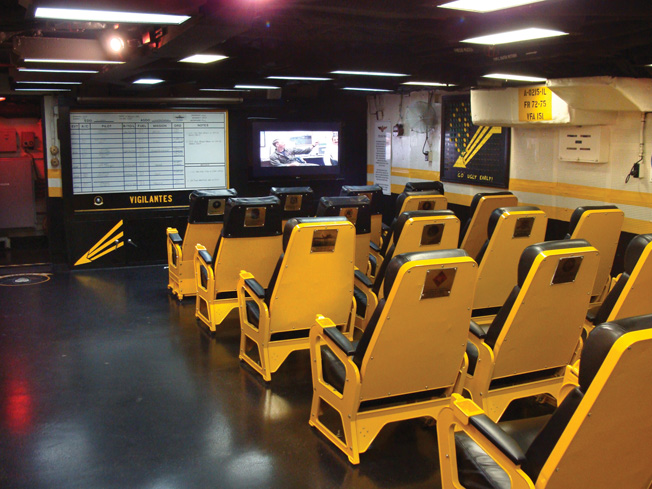
During her service, Midway made several noteworthy achievements. In 1947, as part of the Navy’s budding missile program, she was the only ship ever to launch a German V-2 rocket successfully. Arriving off the shores of Vietnam in the spring of 1965, pilots from Midway were the first Americans to shoot down an enemy MiG fighter jet in the war. After a return to the United States for a controversial modernization project, Midway went back to Vietnam in 1971 to conduct further combat missions. On January 12, 1973, two of her flyers shot down a MiG17 with a Sidewinder missile.
It was perhaps fitting that a carrier with so much service in Vietnam returned in 1975 along with three other carriers and numerous other ships to evacuate South Vietnam after it was defeated by the North. Offloading much of her air wing to accommodate extra helicopters, Midway rescued more than 3,000 refugees. The final combat missions of her air group were flown over Iraq and Kuwait when Midway served as the flagship for the Persian Gulf Battle Force. In 1992, the ship was decommissioned in San Diego and towed to Bremerton, Washington, to join the inactive fleet.
After a few years on the inactive list, most naval ships are consigned to the scrap yard, but Midway was spared this fate. In San Diego, interest grew in acquiring Midway as a floating museum. Once an agreement had been reached in September 2003, the carrier was towed to San Diego, making a brief stop in Oakland for a fresh coat of paint. Midway arrived at her permanent berth on January 10, 2004, and the museum opened on June 7 that year. More than 3,000 visitors toured the ship on her first day as an attraction.
A Tour Through the USS Midway
The first thing that strikes a visitor to Midway is her size. This ship is enormous, towering over the pier and adjacent parking lot. A sturdy gantry leads up to the main entrance on the ship’s hangar deck, where visitors can pick up an electronic tour guide with a set of earphones. Midway’s audio guides are easy to use. As you walk through the ship, you will see numbers posted next to the various exhibits. Simply punch in the number on the guide’s keypad and press the play button. A description of the exhibit will play, explaining what you are looking at and how it worked in relation to the rest of the ship. Many include audio recordings of former Midway sailors describing their personal experiences. The museum has gone to great lengths to portray the everyday lives of sailors aboard ship. Midway’s crew numbered 4,500 in all, with each man having to perform his particular job to keep the carrier operating. Walking through the ship and listening to the crew’s testimonials gives visitors some idea of the thousands of individual tasks involved with running a giant aircraft carrier.
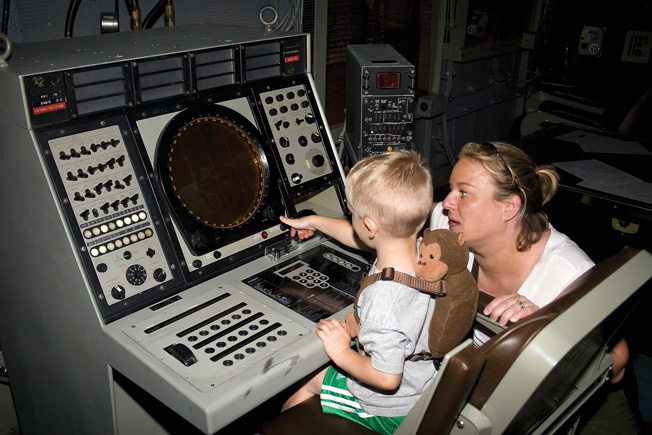
The tour is self-paced, and visitors are free to wander at their own speed. Along with the audio guides, museum docents are posted throughout the ship, ready to answer specific questions. Most of them are former sailors who served aboard aircraft carriers, although not all on Midway. They add a rich level of detail to the experience.
Exhibits on the Hangar Deck
The exhibits run the gamut of the ship’s service, from the post-World War II period through Desert Storm and the early 1990s. Immediately to the right of the hangar deck entrance sits a restored Vought F4U Corsair fighter, perhaps the most recognizable carrier aircraft of World War II due to its distinctive gull wing design. Beyond is a display dedicated to American carrier aviation. Paintings of various carriers and plaques listing the classes and names of all of America’s flattops surround a large-scale model of the USS Gambier Bay (CVE73), an escort carrier sunk during the battle off Samar by a Japanese task force led by the battleship Yamato on October 25, 1944.
The rest of the hangar deck contains not only historic military aircraft but a number of attractions designed for tourists of all ages. Two more of World War II’s famous naval aircraft are on display, a Douglas SBD Dauntless and Grumman TBM Avenger. The Dauntless was America’s prime dive-bomber during the first half of the war, destroying the Japanese carrier fleet at Midway and turning the tide in the Pacific War. The Avenger torpedo bomber made its first appearance at the Battle of Midway, when six of them took part in the attack on the Japanese Navy. Although five were lost in their first engagement, the aircraft went on to do good service throughout the war.
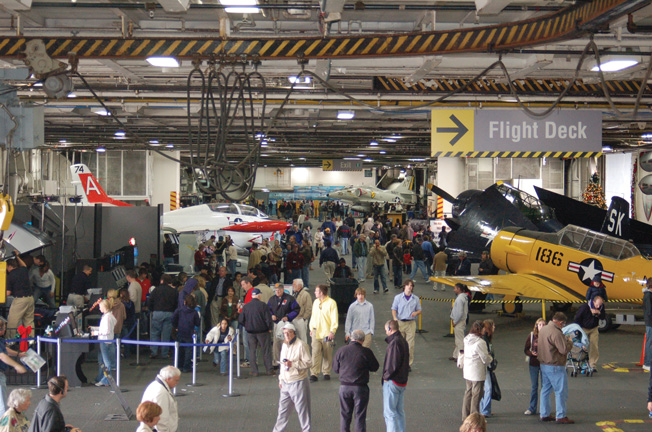
Mixed in among the aircraft on display in the hangar deck are groups of interactive simulators and devices designed to let visitors experience military flight in a number of different ways. The simplest of them are actual cockpit sections from real aircraft, such as the F4 Phantom and F8 Crusader. One can climb in, stare at the vast array of buttons, switches, and displays and imagine what it must have been like to soar through the skies over Vietnam or elsewhere. Farther aft on the hangar deck are a number of video flight simulators that replicate the thrill of flying a combat aircraft; some even twist and turn, taking the rider through full 360-degree turns and rolls. A size requirement prevents smaller children from taking part, but there are other simulators that offer a gentler ride that children can enjoy.
The rest of the hangar deck is taken up with various displays telling the history of Midway and her technical specifications. The mechanically inclined will enjoy a selection of the more common naval aircraft engines. At the rear of the deck are restrooms, a well-stocked gift shop, and a small café serving sandwiches and other snacks. Those interested in learning more about Midway can purchase books about the ship and her sailors written by Scott McGaugh, the museum’s marketing director, who has been involved in the museum for 15 years.
From the Living Quarters to the Flight Deck
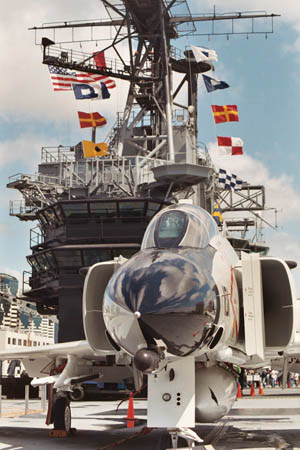
As you make your way around the hangar deck, there are several stairs and a few ladders leading below to those sections of the ship open for viewing. The flight deck may be accessed from the hangar deck by elevator. Following the audio tour will provide detailed information on how and where the sailors aboard Midway lived, worked, and relaxed. The ship’s various living spaces highlight the relatively Spartan conditions aboard a Cold War naval vessel and the differing levels of comfort afforded the crew based on rank. Sailor’s berths are simple bunks with a locker underneath to hold personal possessions, while the captain’s suite spans several rooms. Of particular note is the noncommissioned officers’ mess. One of the few amenities afforded petty officers was a nicer place to eat and relax.
While the living spaces exhibit the conditions and social order of the crew, the various working spaces show just how complex a modern warship is. Literally thousands of sailors had to work at hundreds of different tasks to keep Midway functioning at peak efficiency. Touring the engine room, electrical control spaces, machine shops, sick bay, mess, and laundry facilities highlights just how many separate tasks a warship required.
Moving upward, tourists will see the areas most easily recognizable on a carrier: the flight deck and ready rooms. Well-known from numerous films about fighter pilots, the ready rooms on Midway are full of memorabilia of various Navy fighter squadrons and still contain the seating the original pilots used. There are enough period photographs and aircraft models to keep even the most knowledgeable visitor entertained.
The flight deck holds Midway’s pride and joy, her air group. Spanning the Korean War through Desert Storm and beyond, the aircraft on display represent American naval aviation’s contribution to the Cold War era. Early jets like the F9F Panther sit near state-of-the-art planes like the F/A18 Hornet, still in use today. Most of Midway’s combat service came during the Vietnam War, so aircraft of that era are well represented. Fighters like the F4 Phantom and F8 Crusader line up next to vintage attack aircraft such as the A6 Intruder and A1 Skyraider. Supporting planes are also present, including the E2 Hawkeye and various helicopters. A T2 Buckeye training jet and several of the helicopters are open to allow visitors and their families to sit in the cockpits and rear compartments. In all, some 26 historic aircraft are on display at the museum.
Beside the planes, docents explain the workings of Midway’s steam catapults and the complex operations of launching and landing aircraft aboard what is essentially a giant floating airfield that rose and fell constantly. The carrier’s island offers looks at the bridge, admiral’s quarters, and radio room. The bridge is the only space aboard ship where visitors must wait for a guided tour, which occurs frequently.
San Diego’s Proud Naval Tradition on Display
While Midway is by far the largest thing to see in San Diego harbor, a number of other museums and monuments are well within walking distance and worth spending the effort to visit. Immediately south of Midway’s dock is a row of veteran’s memorials dedicated to San Diego’s proud naval tradition. There are sculptures dedicated to sailors’ homecomings and the USS San Diego, a World War II antiaircraft cruiser that earned 18 battle stars during the war. A nine-foot-tall black obelisk commemorates all of America’s aircraft carriers by name.
Perhaps the most moving tribute is dedicated to Taffy 3, the task force of U.S. Navy vessels that fought in the battle off Samar, part of the larger and better-known Battle of Leyte Gulf. When a large Japanese force attacked the American invasion fleet, all that stood in its way were the destroyers and destroyer escorts of Task Force 77.4.3, known as Taffy 3. Joined by planes from some nearby escort carriers (including Gambier Bay, which was sunk), the tiny, outmatched force attacked the Japanese, putting up stiff resistance and causing so much damage and confusion to the Japanese that they retired without achieving their goal of attacking the vulnerable transports of the American invasion force.
Less than a half-mile north of Midway is another attraction for military history buffs. The Maritime Museum of San Diego offers a number of historic ships from around the world. Two submarines are on display at the museum. First is the USS Dolphin, the Navy’s last diesel-electric submarine. Constructed as a research sub, Dolphin served from 1968 to 2007. In November 1968, Dolphin set a depth record of more than 3,000 feet and fired a torpedo from the greatest depth that one has ever been fired. Much of her career was spent testing the technologies used on current fighting submarines.
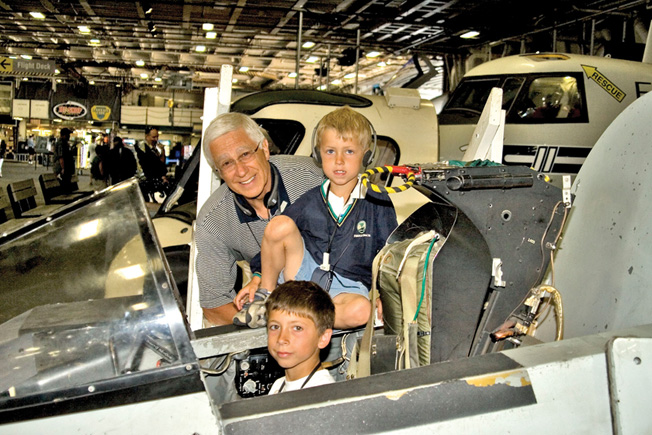
The other sub on display was a fighting boat, the Soviet B-39, a Foxtrot-class submarine. Also diesel-electric powered, the Foxtrots were an enlarged and improved version of World War II-era German U-Boats. B-39 was commissioned in 1974 and served until 1994. In fact, one can see a photo of Midway taken through B-39’s periscope when she once shadowed the American carrier in the Pacific. Walking through the submarine allows one to see how Soviet sailors lived, and it is interesting to note the comparative roughness of the boat’s fit and finish.
The final ship of interest is HMS Surprise, a replica of the 24-gun frigate HMS Rose of the 18th-century British Royal Navy. Built in Canada in 1970 and based on original drawings, Rose spent decades as a sail training vessel before being sold to the 20th Century Fox Company. Renamed Surprise, she was used in the film Master and Commander and later in one of the Pirates of the Caribbean films. In 2007, the museum bought and restored the ship, which still sails occasionally.
Visiting San Diego Harbor
A visit to San Diego harbor offers a number of interesting sites for the individual military historian or family looking for entertainment. It can easily fill a day, and visitors can take their time and still see everything with time set aside for lunch aboard Midway or at a local seafood restaurant. There is adequate parking on Midway’s pier, with all the other sites within easy walking distance. Numerous bicycle taxis move up and down the waterfront if walking is a problem. Midway forms a fitting centerpiece to the San Diego experience. For more information, visit www.midway.org.
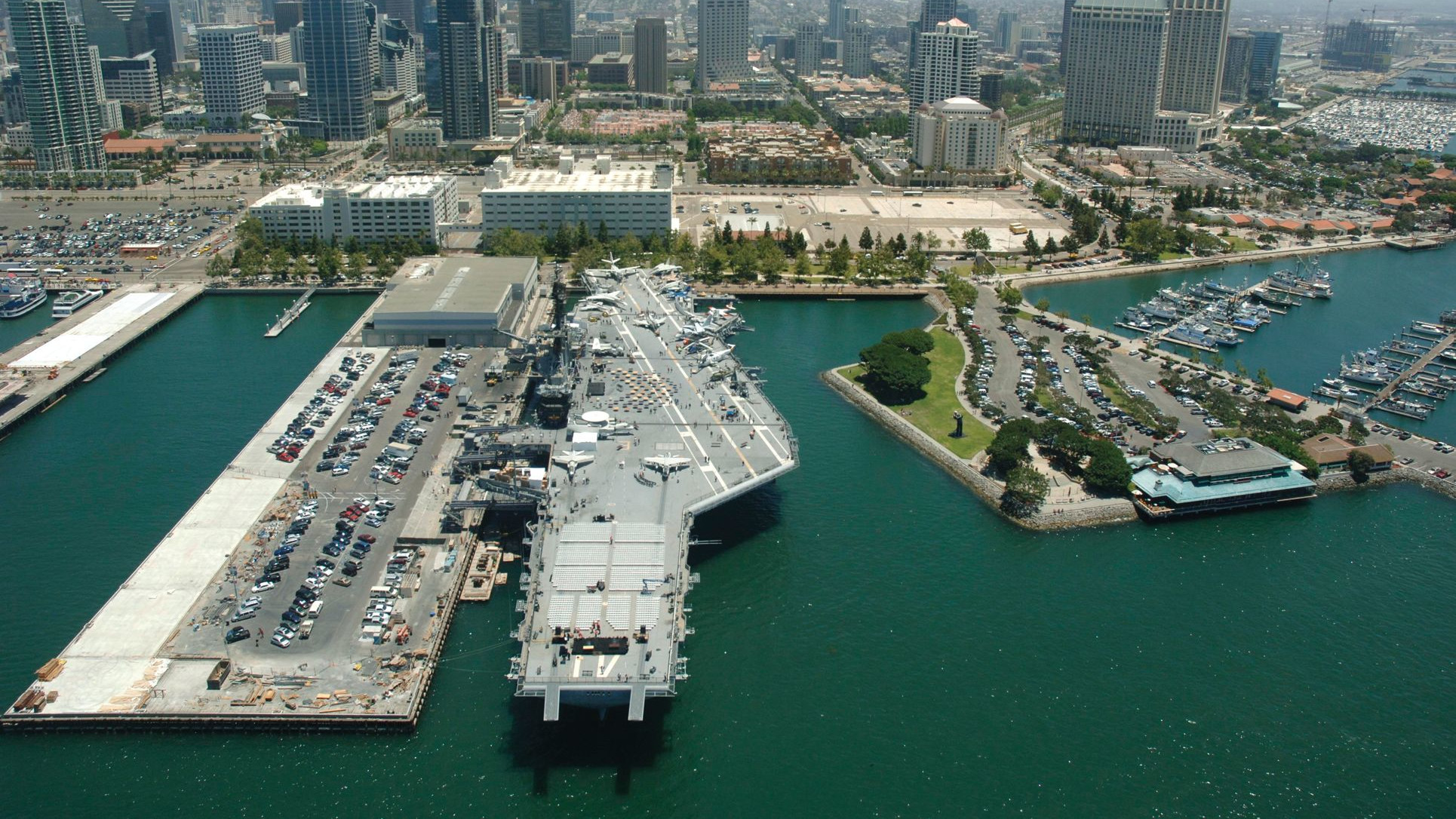
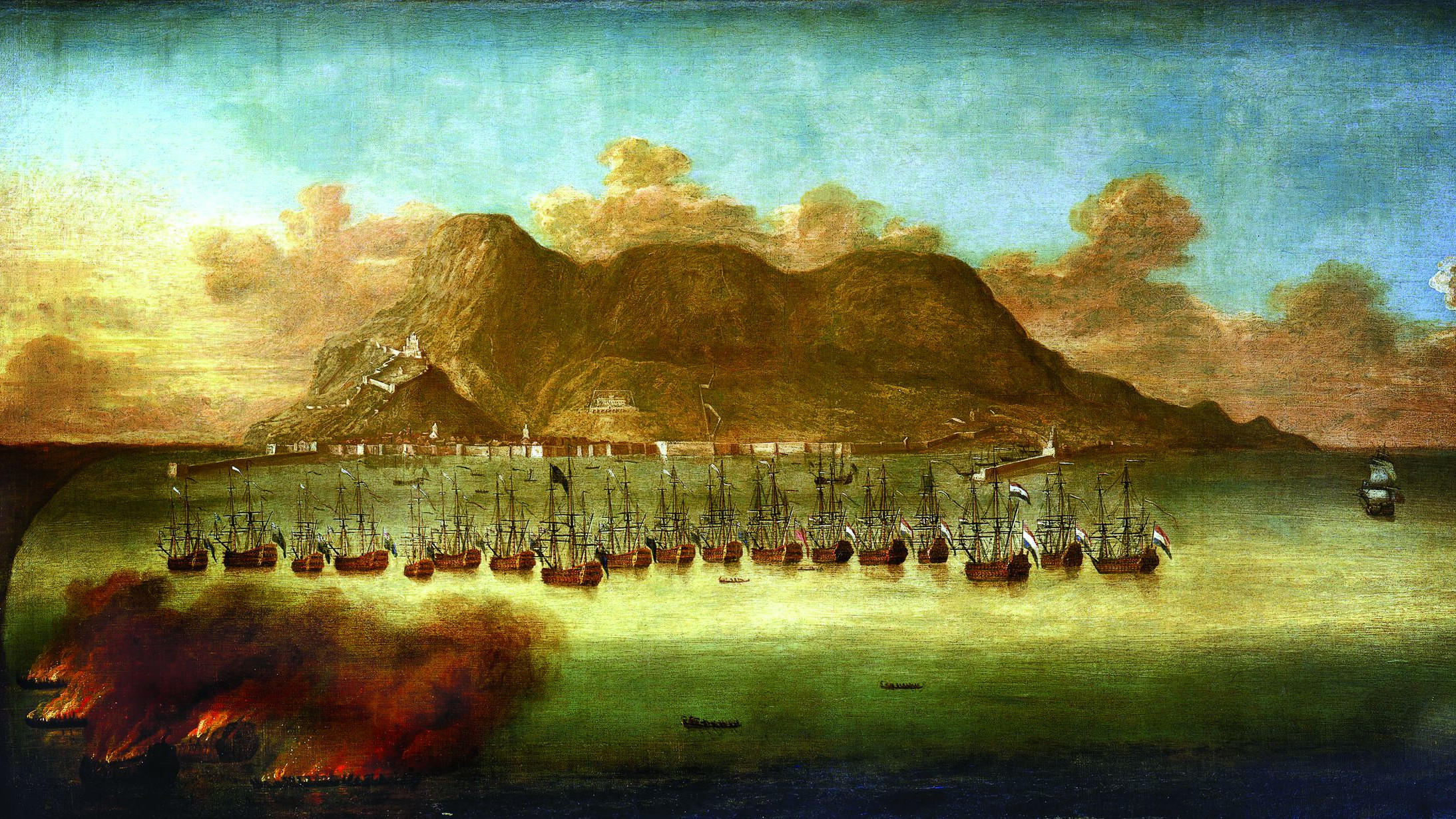


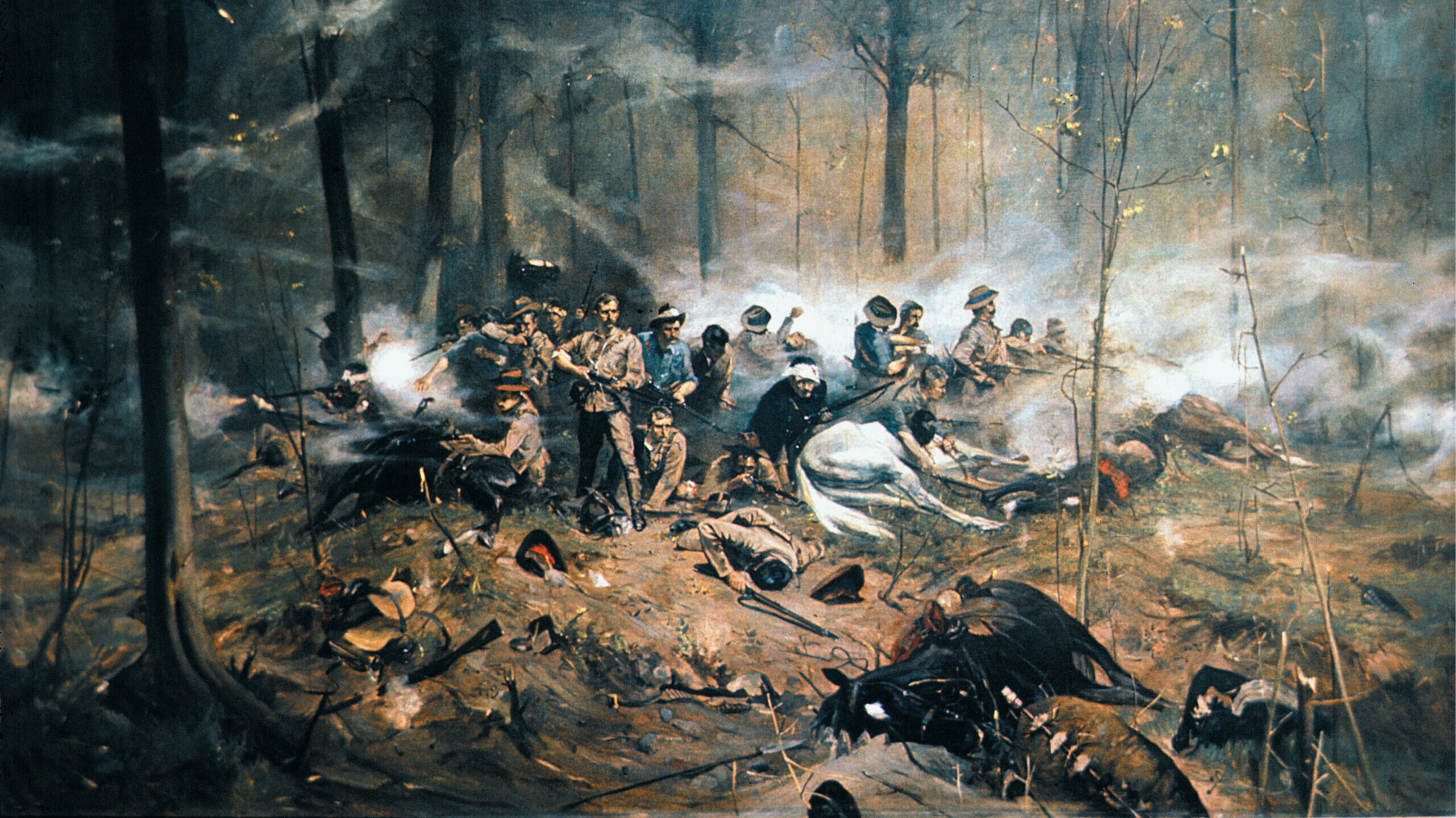
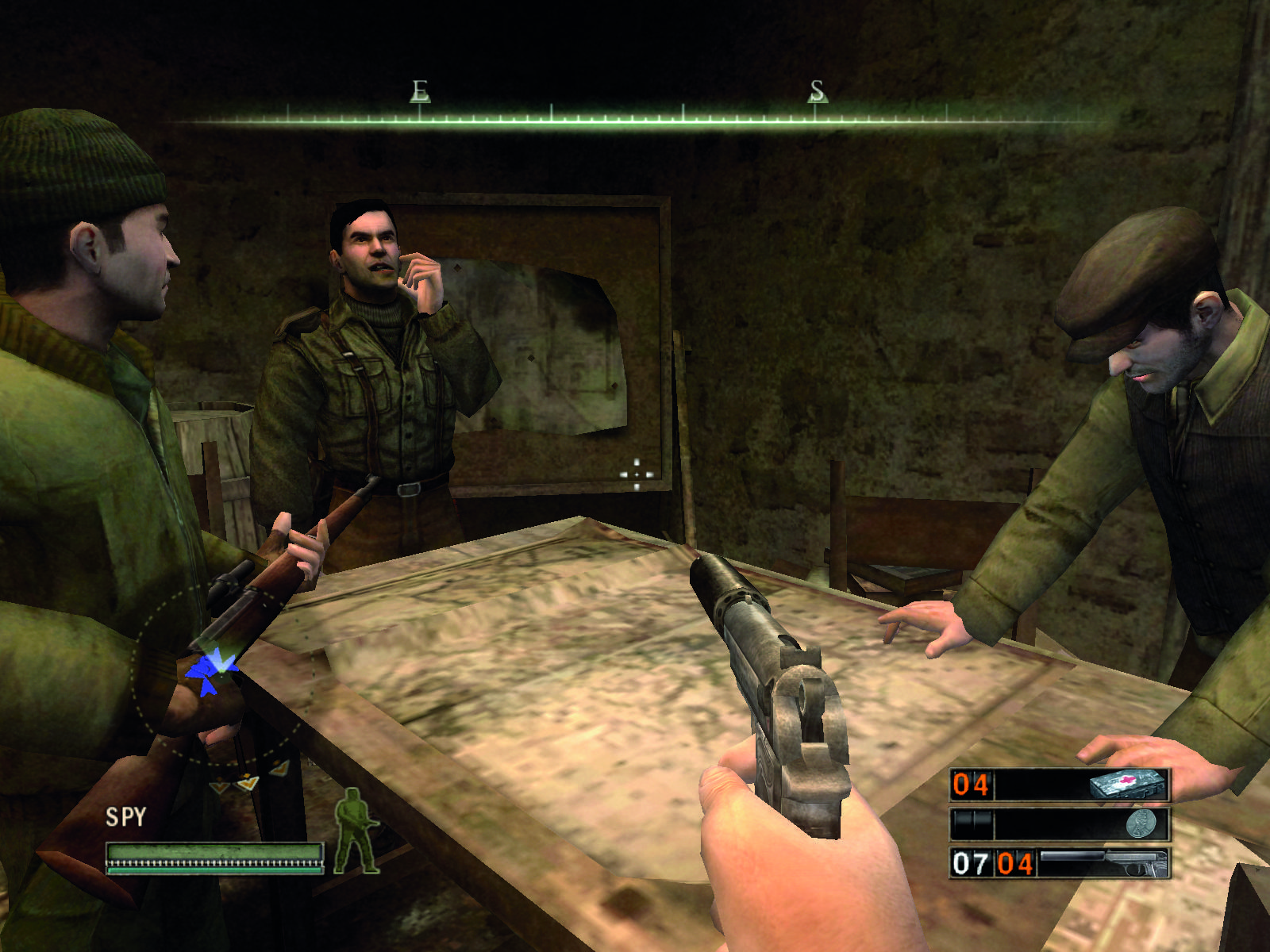


Proud to have served on board. Planning on bringing my Daughter ( A. George Washington navy vet herself and my Grandson some tome this year or next.